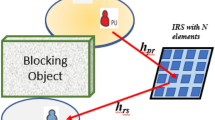Abstract
An In-band-full-duplex (FD) technology-empowered cognitive radio (CR) system with a non-time-slotted primary user activity is presented in this work. FD here means that the transmission and reception can be performed at the same frequency and time simultaneously. Moreover, to incorporate the mobility of the CR, the random waypoint model is used. The non-time-slotted primary user activity implies that the primary and the secondary network are not synchronized. Non-time-slotted means that the primary user can be active or inactive during the CR's sensing/transmission duration. In the conventional time-slotted model, the primary user changes its state during the initial time and not later in the CR sensing window. The performance of the considered FD-CR network is observed in a Rayleigh fading environment. Specifically, the expression for miss-detection probability is derived. It is observed that the CR mobility and non-time-slotted primary activity would very much affect the miss-detection probability. Also, the proposed system with an efficient self-interference suppression mechanism outperforms the conventional half-duplex CRN.






Similar content being viewed by others
References
D. Kim, H. Lee, D. Hong, A survey of in-band full-duplex transmission: from the perspective of PHY and MAC layers. IEEE Commun. Surv. Tutor. 17(4), 2017–2046 (2015)
J. Heo, J. Ju, S. Park, E. Kim, D. Hong, Simultaneous sensing and transmission in cognitive radio. IEEE Trans. Wirel. Commun. 13(4), 1948–1959 (2014)
M. Heino, S.N. Venkatasubramanian, C. Icheln, K. Haneda, Design of wavetraps for isolation improvement in compact in-band full-duplex relay antennas. IEEE Trans. Antennas Propag. 64(3), 1061–1070 (2016)
Y. Liu, P. Roblin, X. Quan, W. Pan, S. Shao, Y. Tang, A full-duplex transceiver with two-stage analog cancellations for multipath self-interference. IEEE Trans. Microw. Theory Tech. 65(12), 5263–5273 (2017)
Z. Li, Y. Xia, W. Pei, K. Wang, D.P. Mandic, An augmented nonlinear lms for digital self-interference cancellation in full-duplex direct-conversion transceivers. IEEE Trans. Signal Process. 66(15), 4065–4078 (2018)
S. Hong, J. Brand, J. Choi, M. Jain, J. Mehlman, S. Katti, P. Levis, Applications of self-interference cancellation in 5G and beyond. IEEE Commun. Mag. 52(2), 114–121 (2014)
Y. Zhang, Q. Wu, M. Shikh-Bahaei, Ensemble learning based robust cooperative sensing in full-duplex cognitive radio networks. in IEEE International Conference on Communications Workshops (ICC Workshops), Dublin, Ireland, pp. 1–6 (2020)
M. Amjad, F. Akhtar, M.H. Rehmani, M. Reisslein, T. Umer, Full-duplex communication in cognitive radio networks: a survey. IEEE Commun. Surv. Tutor. 19(4), 2158–2191 (2017)
W. Afifi, M. Krunz, Incorporating self-interference suppression for full-duplex operation in opportunistic spectrum access systems. IEEE Trans. Wireless Commun. 14(4), 2180–2191 (2014)
Y. Liao, T. Wang, L. Song, Z. Han, Listen-and-talk: protocol design and analysis for full-duplex cognitive radio networks. IEEE Trans. Veh. Technol. 66(1), 656–667 (2016)
Y. Liao, K. Bian, L. Song, Z. Han, Full-duplex MAC protocol design and analysis. IEEE Commun. Lett. 19(7), 1185–1188 (2015)
A. Nasser, A. Mansour, K.C. Yao, H. Abdallah, Spectrum sensing for half and full-duplex cognitive radio, in Spectrum Access and Management for Cognitive Radio Networks. (Springer, Singapore, 2017), pp. 15–50
P.V. Tuan, I. Koo, Throughput maximisation by optimising detection thresholds in full-duplex cognitive radio networks. IET Commun. 10(11), 1355–1364 (2016)
W. Cheng, X. Zhang, H. Zhang, Full-duplex spectrum sensing in non-time-slotted cognitive radio networks. in 2011-MILCOM 2011 Military Communications Conference IEEE, pp. 1029–1034 (2011)
Y. He, J. Xue, T. Ratnarajah, M. Sellathurai, Full-duplex spectrum sensing for multi-antenna non-time-slotted cognitive radio networks. in 2016 IEEE 17th International Workshop on Signal Processing Advances in Wireless Communications (SPAWC) IEEE, pp. 1–6 (2016)
S. Ha, W. Lee, J. Kang, J. Kang, Cooperative spectrum sensing in non-time-slotted full-duplex cognitive radio networks. in 2016 13th IEEE Annual Consumer Communications & Networking Conference (CCNC) IEEE, pp. 820–823 (2016)
T. Hou, X. Ji, Z. Li, Y. Li, Cooperative spectrum sensing for non-time-slotted full-duplex cognitive radio networks. in 2016 IEEE International Conference on Network Infrastructure and Digital Content (IC-NIDC), Beijing, pp. 139–144, (2016)
C. Bettstetter, H. Hartenstein, X. Pérez-Costa, Stochastic properties of the random waypoint mobility model. Wireless Netw. 10(5), 555–567 (2004)
Y. Zhao, P. Paul, C. Xin, M. Song, Performance analysis of spectrum sensing with mobile SUs in cognitive radio networks. in 2014 IEEE International Conference on Communications (ICC), IEEE, pp. 2761–2766 (2014)
D. B. Rawat, T. Amin, M. Song, The impact of secondary user mobility and primary user activity on spectrum sensing in cognitive vehicular networks. in 2015 IEEE Conference on Computer Communications Workshops (INFOCOM WKSHPS), IEEE, pp. 588–593 (2015)
Author information
Authors and Affiliations
Corresponding author
Additional information
Publisher's Note
Springer Nature remains neutral with regard to jurisdictional claims in published maps and institutional affiliations.
Rights and permissions
About this article
Cite this article
Rao, A.K., Sabat, S., Singh, R.K. et al. Cooperative Spectrum Sensing using Mobile Full-Duplex Cognitive Radio and Non-time-slotted Primary user Activity. Trans. Electr. Electron. Mater. 22, 679–686 (2021). https://doi.org/10.1007/s42341-021-00283-7
Received:
Revised:
Accepted:
Published:
Issue Date:
DOI: https://doi.org/10.1007/s42341-021-00283-7




